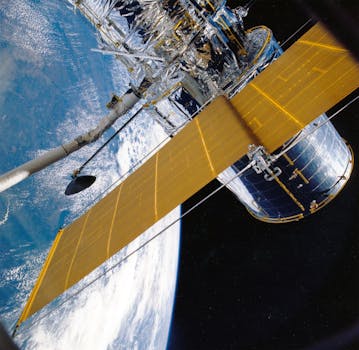Orbiting Innovations: Key Updates in Satellite Telecommunications Technology

Orbiting Innovations: Key Updates in Satellite Telecommunications Technology
Orbiting Innovations: Key Updates in Satellite Telecommunications Technology has revolutionized the way we communicate and access information. The satellite telecommunications industry has witnessed significant advancements in recent years, driven by innovations in orbiting technology. At the forefront of this revolution is the development of new satellite constellations, advanced propulsion systems, and sophisticated communication protocols. In this article, we will delve into the key updates and trends shaping the future of satellite telecommunications.
The use of satellite telecommunications has become increasingly prevalent in recent years, with applications ranging from navigation and communication to weather forecasting and remote sensing. The demand for satellite-based services is expected to continue growing, driven by the increasing need for global connectivity and the proliferation of connected devices. As a result, the satellite telecommunications industry is investing heavily in research and development, with a focus on improving the efficiency, capacity, and affordability of satellite-based services.
One of the most significant advancements in satellite telecommunications is the development of new satellite constellations. These constellations, comprising hundreds or even thousands of small satellites, are designed to provide global coverage and high-speed connectivity. Companies such as SpaceX, OneWeb, and Amazon’s Kuiper Systems are leading the charge in this area, with plans to launch thousands of satellites in the coming years. These constellations will enable a wide range of applications, including broadband internet, IoT connectivity, and 5G networks.
Advanced Propulsion Systems
Another area of innovation in satellite telecommunications is the development of advanced propulsion systems. Traditional satellite propulsion systems rely on chemical fuels, which are heavy, expensive, and limited in terms of maneuverability. New propulsion systems, such as electric propulsion and advanced ion engines, offer significant improvements in terms of efficiency, flexibility, and cost. These systems enable satellites to maintain their position and altitude more accurately, reducing the need for fuel and increasing their overall lifespan.
The use of advanced propulsion systems is also enabling the development of new satellite architectures, such as mega-constellations and satellite swarms. These architectures rely on large numbers of small satellites, which can be launched and operated at a lower cost than traditional satellites. By using advanced propulsion systems, these satellites can be maneuvered and maintained more efficiently, reducing the overall cost of the constellation and improving its performance.
Sophisticated Communication Protocols
In addition to advancements in satellite constellations and propulsion systems, the satellite telecommunications industry is also witnessing significant innovations in communication protocols. New protocols, such as beam-hopping and frequency hopping, enable satellites to communicate more efficiently and effectively with ground stations and other satellites. These protocols also provide improved security and resilience, reducing the risk of interference and cyber attacks.
The development of sophisticated communication protocols is also enabling the use of satellite telecommunications in new and innovative ways. For example, the use of satellite-based communication protocols is enabling the development of autonomous vehicles and drones, which rely on satellite navigation and communication to operate. The use of satellite-based communication protocols is also enabling the development of smart cities and IoT applications, which rely on satellite connectivity to collect and transmit data.
Challenges and Opportunities
Despite the many advancements in satellite telecommunications, the industry still faces significant challenges and opportunities. One of the major challenges is the issue of space debris, which poses a significant risk to the operation of satellites and the overall health of the space environment. The industry is also facing increasing competition and regulatory challenges, as governments and private companies seek to establish themselves in the market.
However, the opportunities in satellite telecommunications far outweigh the challenges. The industry is expected to continue growing, driven by the increasing demand for global connectivity and the proliferation of connected devices. The development of new satellite constellations, advanced propulsion systems, and sophisticated communication protocols is enabling a wide range of new applications and services, from broadband internet and IoT connectivity to 5G networks and autonomous vehicles.
In conclusion, Orbiting Innovations: Key Updates in Satellite Telecommunications Technology is driving the future of satellite telecommunications. The development of new satellite constellations, advanced propulsion systems, and sophisticated communication protocols is enabling a wide range of new applications and services, from broadband internet and IoT connectivity to 5G networks and autonomous vehicles. As the industry continues to evolve and grow, it is likely that we will see even more innovative solutions and applications emerge, transforming the way we communicate and access information.




